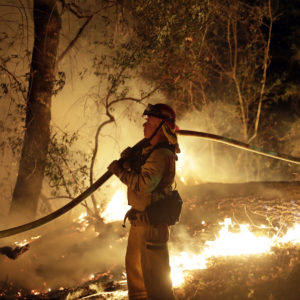Editor’s Note: For another viewpoint, see Point: Wildfires Prove There Is No Time for Delay in Rejecting Fossil Fuels
The catastrophic wildfires raging up and down the West Coast should force a radical reversal of 30 years of disastrous government policies.
Instead, the politicians and environmental pressure groups who gave us these policies are using climate change as a smokescreen to avoid blame and to prevent the change of direction in management needed to restore health to our forests and thereby reduce fire risks.
We might be able to forgive those who, like Democratic presidential nominee Joe Biden, know nothing about what they are talking about when they blame the fires on climate change.
It is enough to point out that the big fires are occurring almost exclusively on public land — national forests, Bureau of Land Management forests and rangelands, and state forests — and not on privately owned forests.
But the Sierra Club, founded by John Muir in 1892 to protect Yosemite National Park and other wonders in California’s Sierra Nevada Mountains, should know better. The Sierra Club has led the campaign to end active management of our public lands and since 1996 has officially opposed commercial logging in all national forests.
Yet here is a statement published on August 27 by the Sierra Club’s executive director, Michael Brune: “If any good can come from this fire season, let it be that it serves as a wake-up call for our politicians. We must end the cycle of putting fossil fuel interests before public health and safety — right here, and right now. … California can set the standard for environmental policies across the country. If we sharply reduce emissions, we show the rest of the US what’s possible.”
While Congress has not legally banned commercial logging, Sierra Club allies like Reps. Peter DeFazio, D-Ore., and Jared Huffman, D-Calif., who represent two of the districts hardest hit by this year’s fires, have successfully pushed for management changes that come pretty close to a ban.
Timber production from national forests averaged 12 billion board feet (bbf) per year in the 1980s. As a result of the “timber wars,” which most notably included listing of the spotted owl as a threatened species under the Endangered Species Act in 1990, timber production declined precipitously through the 1990s and has averaged between two and three bbf since 2000.
The Trump administration, to its credit, has tried to increase the cut to at least four bbf in the face of fierce opposition from Congress and the environmental movement.
Cutting two bbf of timber a year while growing trees add between 14 and 17 bbf a year in total forest volume has inevitably led to massive fuel buildup. And massive fuel buildup inevitably leads to disease and insect infestation and eventually to catastrophic fires.
Bill Dennison, former president of California Forestry Association, is one of the many professional foresters who warned in the early 1990s of the consequences of closing the national forests to logging.
But you don’t need to be a professional forester to see that those warnings have come true. Anyone driving through forests in the Sierra Nevada, the Cascade Mountains, or the Coast Range can see the destruction.
Tens of millions of dead trees as a result of bark beetle infestations. Endless thickets of unhealthy small trees where there should be mighty stands of Douglas Fir or Ponderosa Pine. And huge areas — more and bigger every year — that have been incinerated by fire, leaving nothing but blackened trunks and wildlife carcasses.
In the face of this environmental and economic catastrophe, there have been calls for modest reforms.
Some advocate more prescribed burns. Others promote more programs to thin overgrown thickets. There is even a bill in Congress to allow salvage logging without the environmental reviews (followed by lawsuits) that now last so long that the dead or burned timber has decayed so much that it is worthless before salvage begins.
But these reforms are mere Band-Aids when a heart transplant is the only thing that will save the patient. If we are going to save our public forests and reduce the risk of catastrophic fires, a healthy timber industry must be restored.
It won’t be easy. Overcoming intense opposition to logging is only the first step.

